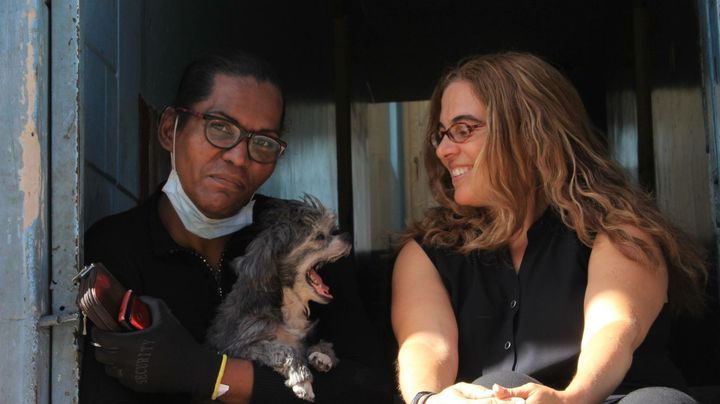“Prostitution opened every door for me I ever wanted.”
This first time I met Diana Navarro Sanjuán, she introduced herself by saying, “Hello, I’m Diana. I’m queer, I’m black, and I’m a prostitute.” That’s how I learned the Spanish word puta. Diana is a force of nature and makes grand entrances, and certainly she was the most flamboyant person in the staid Starbucks where we met in in the center of Bogotá, Colombia. I met Diana through my friend filmmaker Carmen Oquendo-Villar, who has been making a documentary about Diana, her unique neighborhood in Bogotá, Santa Fe, and her efforts to organize and advocate for the transgender sex worker community—among others—there.
Human rights advocates frequently talk about the indivisibility of human rights, but I never understood that concept viscerally until I met Diana; perhaps she could bring it to life for me because she trained as a lawyer and but lives as a sex worker and activist. Having studied law, a feat that Diana notes proudly she paid for with sex work, this Afro-Colombian has personally lived every form of oppression: displacement because of Colombia’s 50+ year armed conflict, physical violence, marginalization, and stigma. These are not the only experiences that define her, though; to meet Diana is to encounter somebody who embodies strength and nurturing, social defiance and community-building, silk and steel.
Diana tenaciously asserts that she is unwilling to accept that people accept her rights as a black person, as a transgender woman, or as a refugee unless they also accept her rights as a prostitute (she herself rejects the term “sex worker” and prefers “prostitute”). “I knew I had the right to develop myself as I wanted,” Diana explains, “and that’s exactly what I did…. [Prostitution] allowed me to do social work, learn, travel, enjoy life.” One of the questions I often hear people ask about sex work is whether or not sex workers who claim to enjoy their work would—given other opportunities—choose another line of work. Diana doesn’t quibble over that hypothetical conundrum for even a minute: “prostitution opened every door for me I ever wanted,” she says, and moves on.

Diana uses her outsize personality and confidence to advocate for other sex workers, and in doing so, has become a force to be reckoned with in her Bogotá neighborhood of Santa Fe. The transformative power of sex work is, for her, not only individual but collective. Santa Fe is home to an experimental social policy in which Diana is intricately embedded: through the creation of Zona Especial de Servicios de Alto Impacto, or “Special Zones for High-Impact Services,” the government is recognizing sex work as a profession, in some ways “legalizing” it, or at least turning a blind eye. Once an enclave of wealthy Jewish immigrants, Santa Fe has become a destination not only for sex workers but also for impoverished refugees, ex-paramilitary forces, and former guerrillas from all corners of Colombia. Diana sees this as an important transformation and proudly contributes to it. Diana plays a crucial role as broker between the police, the government, and the new denizens of Santa Fe.
Diana and Carmen met a decade ago, when Carmen had been invited to go to Colombia and use theatre techniques to promote dialogue between the police and sex workers, a training that Diana participated in. Carmen, an award-winning documentarian who has created a series of films about transgender Latina women, was immediately struck by Diana’s strength of character and her unapologetic embrace of sex work. In a way, the two were made for each other: in the way that Diana advocates for sex workers and other marginalized people in Santa Fe, Carmen has similarly used her documentaries to humanize transgender Latina people in numerous settings. Both are using their skills to fight for social inclusion.

In some ways, Diana seems to be following a fundamentally Christian model, demonstrating the same radical stance that Jesus Himself once did—as evidenced by her open embrace and political promotion of sex workers, the poor, the displaced. Perhaps unsurprisingly, not everybody in Santa Fe is enamored of Diana’s contributions to the community: as Carmen met with local authorities at city hall in Bogotá to discuss the documentary, one of them said, “Diana Navarro is merely part of a minority in Santa Fe. She isn’t a leader here. The LGBTI community has its own dynamics.” The Pharisees couldn’t have said it better themselves.
Telling Diana’s story and understanding why her contributions to Santa Fe, to Bogotá, and to Colombia are more important than ever, given that Colombia has just concluded a years-running peace process; for the first time in three generations, the country seems to have a real chance at peace. Diana and Carmen are asking us the questions that the country—and each community within it—will need to answer: will the new Colombia truly include a place in the square for everyone?
To learn more about the making of the documentary “Diana de Santa Fe,” please visit https://www.indiegogo.com/projects/documentary-diana-de-santa-fe-lgbt-transgender#/ or the film’s Facebook page at https://www.facebook.com/dianadesantafe/
